#and there's biosecurity protocols to get in and out
Explore tagged Tumblr posts
Text
Getting everything in order to move into an apartment and the landlord keeps suggesting work hours for times I can get the keys and it's taking everything I have not to say "sorry, some of us have real jobs"
#ceaseless rambles#generally I'm opposed to hating on landlords for “not having real jobs”#because the actual issue is that they exploit people's needs for housing and lock things necessary for survival behind fuckoff high prices#and there's nothing wrong with not having a job#as long as your method of making money isn't exploiting people#but dude. I've said multiple times i get off work at 3:15 and i can do it right after that#and he keeps suggesting times before that#do you not understand how this works#it's extra annoying because i can't even access my phone during work hours#and there's biosecurity protocols to get in and out#and he's just kinda ignoring that#agh
17 notes
·
View notes
Text
hi gang!
lin reporting for duty! bringing you moon jiho, codename seraph, fashioned after aegis' very own angel skeleton. can't express enough how excited i am to be around here and get started and i'll be reaching out to everybody very soon!
there are several different places where you can get more info on this angel, but the first point of call is this little dossier that connects you to everything. hope you enjoy reading them but will have a brief summary under the cut for some quick reading and if you have any questions of course i'm always happy to help!
hoping to have wanted plots and connections posted soon but happy to start brainstorming for some ideas! open to plot over discord if anyone prefers it and also i am very new with tumblr rp so please be patient with me :)

jiho as seraph is the chief medical officer and toxins specialist at aegis international. he's a legacy recruit following the footsteps of his father and grandfather.
he's responsible for developing and overlooking operation shadowscape. which takes aegis existing medical protocols, refined and modernised the whole thing. this earned him the title of chief medical officer in the agency.
he can be silly and goofy and has a lot of eccentric hobbies and likes but takes his work very seriously.
seraph mostly deals with high-level missions and pretty serious medical emergencies but is the agency's go-to person for biosecurity and the dark arts of toxins.
only a handful of agents have encountered seraph at the agency. His unassuming appearance lets him fly under the radar and pass for some low-level agent, and he totally plays into it.
if you are the one who's on the operating table, the last thing you want is for seraph to show up ;)
6 notes
·
View notes
Note
PLEASE tell me more about how you came to be riding bareback on a horse down a mountain in a stampede. This lore is fascinating
Ok, so, bit of backstory: when I was in my early teens and had no experience with horses at all I got suckered into this Very Bad Barn. I feel quite embarrassed and ashamed about this. It was bad for many reasons, but without being excruciating these were the main issues in hindsight:
1) It had lax to nil safety considerations (no insurance, unqualified instructors in their early teens, only let us ride bareback because they didn't want to maintain school tack, didn't actually teach proper riding skills, etc)
2) manipulative and abusive social structure (compelled to volunteer with no compensation or lose your space, lots of gaslighting/moving the goalpost, the group of teens I was with were super fucked up and did a number on my mental health, the adults were even worse especially the barn owner - I have actually run the BITE model used to assess cults against this place and it places alarmingly high)
3) financial abuse - including but not limited to exorbitant prices for what was offered, 'gifting' horses to kids like me who didn't know better (no papers exchanged - paid for a horse for years and took care of all bills, etc only to have him taken away and been embargoed from seeing him when I had a disagreement with barn owner)
4) TERRIBLE horse welfare - I don't want to go into detail on this because it is still very raw, but the worst was a combination of not letting horses be pulled out of lessons despite injury + no biosecurity protocol = disastrous and fatal consequences
Ok, that actually ended up being excruciating detail, sorry about that. Depressing details out of the way, now onto the funny/dramatic part.
So all of this culminated in me, not knowing how to ride very well but thinking I was competent, riding multiple times weekly in groups of about 10 people who were also incompetent but confident (a dangerous combo) bareback in the mountains. The mountains where I live are steep, rocky semi-alpine, and where we rode usually reached a height of about a kilometer.
One of these rides I was in the middle of a group of said riders. We were making our way slowly up the mountain, which was a rather wide trail at that point with very large gravel, probably 45 angle iirc, and had almost reached the top of the mountain. I think there were about 4 horses in front of me and 4 or 5 behind me (cannot remember the exact number) and I was in the middle. I think I was about 20. It was sunny and we were all pretty relaxed and not paying attention, especially the ride leader. I am not sure what the ride leader's horse saw or heard, but he spooked hard and fast. The sleepy ride changed in an instant. All the horses spun 180 fast, unceremoniously dumping their riders onto the gravel. Except me. I missed my chance to fall relatively safely, and by the time my brain caught up with what was happening it was too late to make a last ditch attempt at 'dismounting' (read:falling).
The horses took off at a dead gallop down the mountain. I would say it was probably about half a km on the straightaway before the gravel path started to curve (thankfully the curve was pretty gradual) and head into the forest. I had a death grip in my horse's mane, and was using all my leg strength to hold on (keep in mind, due to the abysmal nature of this barn, I had very little experience cantering and had never galloped in my life. What little times I had cantered had all been on straight stretches with no turns). The horses were clumped right around me, so there was no place I could see to fall where I didn't run the risk of getting trampled or kicked in the head. When we got into the forest the situation got more dire as the path narrowed and the horses maintained their pace, but clumped even tighter. I'm not sure how likely I was in reality to be seriously or fatally injured if I had fallen off, but my thoughts were very loudly telling me that injury or death was a possibility so I didn't want to risk it.
Once we reached the forest it wasn't long before we encountered the stream. A tiny stream, but a short and sharp dip down to the water and then a short and sharp dip back up. They thankfully avoided the bridge. I don't actually remember riding the stream - did they jump the bank? Trip on rocks? I don't know, fear blurred my memory. And then we were continuing on the narrow forest path, me in my stampede, and I wondered how much longer I would be in hell and what I was going to do when the horses stopped - and would they stop? Then we were across the (fairly deserted, thank god) road and at the trailers. Finally the horses drew to a stop. I leaned forward and slid off my horse's neck, and here my legs collapsed and I actually did fall, slightly under his chest but by this time Jace has regained some of his senses and brought himself up so he didn't step on me.
My legs were raw from where I had been slamming my inner thighs into his withers - as I mentioned I had never been taught proper riding. If this happened now (which it wouldn't because I am at a Safe and Accredited barn, but I digress) I would be physically able to ride it better, but where I was then I had been relying very strongly on my death grip in his mane to stay on (the horses were very reactive to having leg pressure on them so we always rode with our legs slightly off the horse's sides, which resulted in us more or less balancing entirely on our pinbones. It took me probably 4 or 5 months when starting at a proper barn to start consistently keeping my leg on horses while riding because I was so conditioned to expect them to try take off when your legs touched their sides). I had basically been getting a few inches of air every stride before slamming back down. Poor Jace. Poor me.
There I was, with around 10 loose horses is very stages of remaining panic, frantically trying to catch everyone and tie them to the trailer. One of them, Thor, would not stop loosing his head and kept circling onto the road, which while relatively deserted still had cars sporadically coming and I do not know how he managed to not get hit - I couldn't get near him. I was bawling my eyes out at this point, but trying to stay calm enough to round everyone up. The equestrian parking lot was bordered by a general use parking lot mainly used by hikers, and there was about 5-10 different groups of people there, but no one offered to help. I could understand it being unsafe for them to help with the horses, but no one even asked if I was ok. What I really wanted was to send someone to check if the people I was riding with were ok - a significant portion of them were seniors and I thought they might have gotten hurt in the fall. One of them I had narrowly missed running over at the start of the stampede. Worst of all, some guy on his atv started to DRIVE HIS ATV THROUGH MY SCARED HERD OF LOOSE HORSES until I ran at him, waving my arms and screaming at him to go another way. I am still extremely indignant about this.
Anyways, thankfully soon after Mr Fucker on the ATV the other group from our barn, who had been riding on trails on the other side of the road, came back and were able to help finish catching the horses and go fetch the fallen people. No one ended up being seriously injured (though I walked with a limp for about a week because my legs actually scarred on the inner thigh) and all the horses were safe. But yeah. Sorry for being kind of long and rambly, I know it isn't really a very exciting story but it's a very strong memory for me.
1 note
·
View note
Text
Day 19 7/16/2021
Hiya! Not a ton to report today. It was a very chill day which was nice after a long week. This morning I got a mini workout in and had some breakfast. Afterwards, Ben and I headed to the lab for a meeting about a new project we will be helping out with in partnership with a high school student in Oahu. This project deals with putting out 3D printed hermit crab “shells” with GPS trackers (they resemble PVC end caps). It’s in really early stages, but it sounds like a really fun project. Following that, we hung around a bit to wait out the rain. Today it rained A LOT. Usually there’s a downpour here and there but it was pretty constant today. Luckily, we got a bit of a break in it and Ben and I did the Sexy Tree survey (just a fun name but it’s a survey of the native tree species on the atoll where we note if they’re flowering or fruiting). After getting all 100 trees (we split up so it would go faster), we had yummy lunch that included a brownie! Yum. In the afternoon, we did some data entry and started our weekly reports. We have two that we send out. One goes to Katie, our boss, which has all that we did that week plus some fun things like what was our favorite project and what did we learn. The second one is a station weekly which goes out to more people. It contains updates, a scientific finding or fact that we encountered, a fun photo we took, and the weather for the week. Later we had a meeting with Katie to go over tasking and what our plan is for the next week. It was a really nice chat! After that, we had a biosecurity meeting with the FWS biological technician. Biosecurity is a hot topic when traveling beyond Cooper Island. Since we all live on Cooper and planes land on Cooper, it is difficult to ensure and control that no foreign species are introduced. There are still protocols in place (freezing all clothes and bags for 48 hours prior to arrival plus other things), but there is already a huge amount of human impact on Cooper so the protocols are less strict. The rest of the atoll is known as the refuge and can only be accessed with special permission by Fish and Wildlife Service. The protocols in place are also much more intense to prevent any cross contamination from Cooper to the other islands. Yes things may float across or make it in the wind, but we want to limit as much crossover as we can. To do that, anyone traveling to the refuge must have a separate, brand new, and frozen outfit that they wear only in the refuge. This helps to prevent any seeds or bugs traveling on our clothes when we do work on the refuge. It’s really exciting that we had this chat because it means we will get to do work on the refuge! Yay! Tomorrow is our first day there and I am really looking forward to exploring more of the atoll. After that meeting, Ben and I headed back to the lab and finished up some computer work. At the end of the work day, I jumped in the water at the swimming hole and then rinsed off. Today was a help yourself leftover dinner so we were on our own schedule this evening which was really nice. I dipped into my St. Croix dark rum (thanks mom and dad), finished my map, and am now writing this.
Now….for some drama…not really but sort of. A catamaran heading from California to an undisclosed location (;)) had a crack in the hull and was looking for safe harbor. An Island somewhat close to us did not let them anchor since they were weary of a foreign boat and surprise the next closest land mass was us. So they had to sail here in order to sort out the issue. They seem super nice, but this is not a normal thing on Palmyra. When people want to sail here or visit they have to buy a permit and it’s not cheap. PS they are not allowed to exit the vessel and come on land. We are all safe and I packed my angry eyes so I can easily fend them off with a glaring look if anything happens. Anyways, there is a little secret inside info for ya! Shhh don’t tell. :). Okay night night.
1 note
·
View note
Text
Decades of Tree Data Reveal Forests Under Attack
https://sciencespies.com/nature/decades-of-tree-data-reveal-forests-under-attack/
Decades of Tree Data Reveal Forests Under Attack

The Blue Ridge Mountains make up one of the oldest mountain ranges in the world. They are also home to forests with diverse tree populations. But those trees are under attack from invasive species, and Smithsonian researchers say that the impact over time is becoming ever more concerning.
According to a study published in the journal Ecosystems on April 29, in a section of the Blue Ridge Mountains, about a quarter of the loss of tree biomass—roughly one-quarter of tree death—over the past three decades was linked to invasive species transported by humans. The study is believed to be the first long-term look at the impact of multiple invasive species on aspects of the forest, the researchers reported.
One of the forest sections they studied is part of the Smithsonian’s Forest Global Earth Observatory, or ForestGEO, a network of sites that monitors changes to forests. The initiative dates to 1980, when Smithsonian researchers began mapping, measuring and tagging trees at a site in Panama. That original plot contained a quarter of a million trees. “No one had ever tried anything like this ever before,” says Stuart Davies, director of ForestGEO.

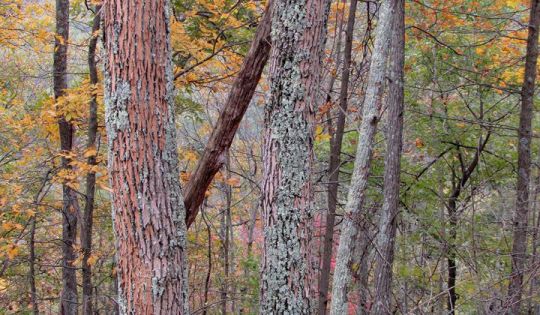


The researchers discovered ash trees infested with emerald ash borer beetles, which get under the bark and disrupt the tissue that brings water and dissolved minerals from the roots to the leaves.
(Alan Tepley, Smithsonian Conservation Biology Institute)
The network now monitors some six million trees inside tropical and temperate forests at 70 sites in 27 countries. The methodology to monitor them is consistent across sites, which makes the program unique. “Unless you measure things in the same way, it’s very hard to compare them,” Davies says. “What we have is a very clearly standardized protocol, where we know if you compare a data set from Gabon with a data set from Brazil, there’s no question.” More than a thousand research articles have come out of the network.
For the new study, the researchers focused on plots inside Shenandoah National Park in Virginia, which contains a section of the Blue Ridge Mountains, and a nearby plot monitored by the Smithsonian Conservation Biology Institute. The team from the Smithsonian and the park looked at 67 plots of forest across 73 acres. The data was from 1987 to 2019 and contained more than 350,000 tree observations.
“We know that pests and pathogens can have a really important impact. But it’s highly variable in time and space,” says Kristina Anderson-Teixeira, a forest ecologist at SCBI and the Smithsonian Tropical Research Institute and lead author of the study. “I wanted to get a broader overall picture of, long-term, how have these been affecting the forests as a whole?”
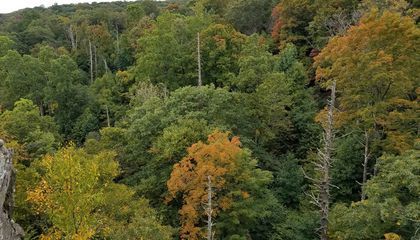
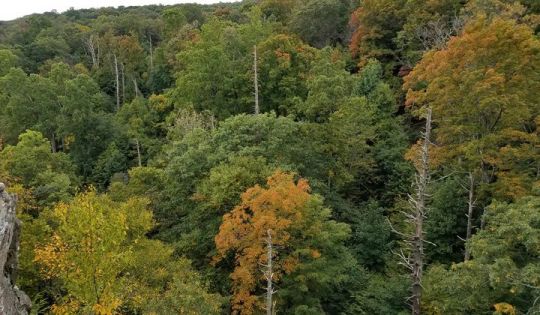
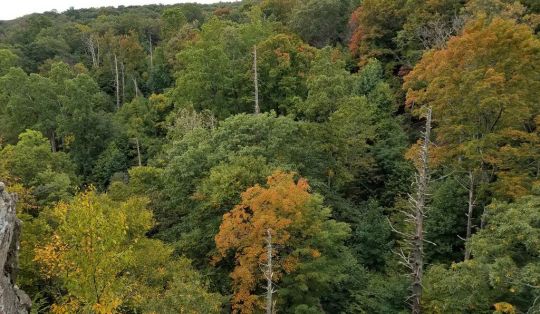

“People need to appreciate forests, recognize that our water, our clean air, so many services that we depend on, are the result of fully functioning, healthy forests,” says Stuart Davies, director of ForestGeo.
(Alan Tepley, Smithsonian Conservation Biology Institute)
The researchers found that the invasive species were tied to around 25 percent of tree deaths over the time period studied. “That’s pretty significant for the functioning of the forest,” Anderson-Teixeira says. “We’re losing cool species, species that we value for one reason or the other.” Normally trees have mortality rates of 1 or 2 percent per year, she says. For the trees that invasive species impacted, the figure was as high as 20 percent.
Changes to the forest affect the animals that live in them. This area is known for bobcats, raccoons, eastern striped skunks and opossums. “There are these cascading impacts of the forest composition on. . . the forest animals,” Anderson-Teixeira says. For example, the gypsy moth, an invasive insect, has devastated oak tree populations in the area, and animals such as American black bears, white-tailed deer, Allegheny woodrats, Eastern gray squirrels, and southern flying squirrels rely on acorns from those trees.
“Due to these invasive species,” says William McShea, a wildlife ecologist with the Conservation Ecology Center at SCBI and one of the study’s 20 authors, “you’re getting a lot more young trees, and that’s a much different forest composition. That benefits some species and doesn’t benefit others.” White-tailed deer flourish with young vegetation and woody plants at the forest floor, for example. But other species, including birds, prefer a more mature forest, according to McShea.
Invasive species aren’t just a problem in the Blue Ridge Mountains; they impact forests throughout the United States. People have documented at least 471 exotic insects and pathogens in forests across the country over the past few centuries, and similar situations exist in Europe and Asia.
The problem is species-specific, so particular invasive species impact particular tree hosts. The researchers identified eight combinations of invasive pests or pathogens and their hosts: American chestnuts suffered from chestnut blight, a fungus from Asia; elms had Dutch elm disease, also a fungus from Asia; redbuds had neofusioccum, a fungus of unknown origin; butternut trees had butternut canker, another fungus from Asia; dogwoods had dogwood anthracnose, yet another fungus from Asia; oaks attracted the gypsy moth, an insect from Europe; hemlocks were victim to hemlock woolly adelgid, an insect from Asia; and ash trees attracted the emerald ash borer, another insect from Asia.
Of the eight tree taxa they studied, seven have species that are now threatened or endangered because of the invasive pests or pathogens, according to the study. The researchers found six more combinations, but those trees declined possibly due to other factors.
Invasive species impact the trees through different means. For example, the emerald ash borer, an insect, gets under the bark and disrupts the xylem, a tissue that brings water and dissolved minerals from the roots to the leaves. Gypsy moths cause leaves to fall off trees.
Because of global trade and travel, invasive species will likely remain a problem. Climate change can make the problem worse, because unhealthy forests are less resistant to exotic species, and those pests and pathogens can spread faster under warmer conditions, according to Anderson-Teixeira.
Invasive species are among several ways that forests are under attack. Forest fires, such as those that burned in the Amazon rainforest in 2019 due to human deforestation, climate change and drought are additional ways. Even native species, such as white-tailed deer, which are in high density in certain parts of Shenandoah National Park, can disrupt the balance of the ecosystem if not regulated. As Anderson-Teixeira puts it, “There’s a lot of pressures on forests these days.”
These threats are evolving. Changes to land use are becoming increasingly worrisome to the forest monitors at ForestGEO. “We’re still losing something between 80 and 100,000 square kilometers of tropical rainforest every year,” says Davies, the ForestGEO director. This deforestation and fragmentation of forests allows other threats to increase, according to Davies. For example, hunting often happens when forests are more accessible to humans; fragmented forests are likely more susceptible to climate fluctuations; and when animals do not stay isolated in their forest habitats, they can transmit pathogens to humans, including coronaviruses.
But the researchers found that overall, the forest they studied remained healthy, even as trees impacted by invasive species died. That’s because forests are resilient.
The average above-ground biomass, a measure of trees above the soil, actually increased, as trees that were impacted less by the invasive pests and pathogens grew. Tree biodiversity also did not change much. “In some patches,” Anderson-Teixeira says, “you’d look around and see more species than you would have in the past. It works because it’s a fairly diverse forest, so you’re losing some species, and less affected species are filling in.”
The study suggests that people and governments prevent invasive species through policy regulations, biosecurity and conservation to make forests more resilient.
“People need to appreciate forests, recognize that our water, our clean air, so many services that we depend on, are the result of fully functioning, healthy forests,” Davies says. “Many people who are stuck at home at the moment are probably starting to realize, ‘Heck, I didn’t realize how much I really appreciate being outside and walking in the park.”
#Nature
2 notes
·
View notes
Note
For the ask meme, would you please do 1, 2, 4, 5, and 11 for 'The Case of Kogan,K' ? (and the same ones for maybe 'Under the Radar'), if you want? Also number 13 for all your fics in general; thanks! <3
Thank you so muchfor the ask! :D <3 <3
Questions are fromthis ask meme! (Links to fics: The Case of Kogane, K. and Under the Radar)
1. What inspired you to write the fic thisway?
Kogane, K.: *tries to think of what ‘thisway’ means* What inspiredme to write the fic was the thought that Keith isn’t the type who would dosomething to land himself in prison unless his life depended on it, so it gotme thinking, well what if he was put in prison for something he didn’t do?
Under the Radar: *tries to think again ofwhat ‘this way’ means* Thisfic came about when thinking what might’ve happened to Keith had the Garrisonfound out about his knife. The thought that Keith had no one looking out forhim after Shiro left, coupled with the fact that I was studying biosecurity atthe time, … I had some ideas for whump floating around in my head ^^;
2. What scene did you first put down?
I always write thescenes as they come so that I can incorporate the feels of previous scenes intothe later-coming ones I’ve thought of, but in terms of drafting out scene ideas…
Kogane, K.: Oooo it’s been so long and so much hashappened – I can’t remember! ^^; One of the earliest scenes I had envisionedthough was Shiro carrying Keith out of the cell. I was so happy when I finally gotto writing that scene in C9 :’’’)
Under the Radar: The pool-drowning scene, as well as thegeneral idea of Keith being unknowingly kept in a lab environment somewhere atthe back of the Galaxy Garrison campus, were probably the first scenes I had inmind for the fic :o
4. What’s your favourite line of dialogue?
Kogane, K.: “Because you’re more than just a case file” –Shiro, C21
Under the Radar: “No take backs!” – Lance, C7
5: What part was hardest to write?
Kogane, K.: Writing Keith having to wear handcuffs aspart of prison protocol T.T I hated it as much as Shiro did.
Under the Radar: I felt so sick to the stomach the whole waythrough writing this fic! xD I kept thinking about ideas and detailing scenesin my head in the middle of studying at uni too, and since biosecurity was oneof the papers I was studying at the time, all I could think about was all thatstuff about eradication methods and whatnot being tested on Keith ^^;
11. What do you like best about this fic?
Kogane, K.: I love how dynamic the scenes are. There’sfast-paced, suspenseful scenes, slower-paced, more conversation-based scenes…andso many different intense feels to be had. This fic taught be a lot about howto find different ways to approach the scenes I find more difficult to write(the slower-paced, conversation-based ones), too, and I’m really thankful forthat :’’’)
Under the Radar: I loved the thrill the suspense gave me whenwriting it :’’’) I especially loved writing Lance, Hunk and Pidge figuring outwhat was going on under the radar, caring about what might’ve happened to Keitheven when Keith himself had no idea anyone had even realised he hadn’t beenexpelled.
3. What music did you listen to, if any, to get in themood for writing this story? Or if you didn’t listen to anything, what do youthink readers should listen to to accompany us while reading?
I often listen to music whileI’m writing! Usually it’s more background music that I listen to, or if it’sspecific to the mood of the chapter/scene I’m writing, then it’ll be to help mechannel the feels when I’m trying to put words to intense emotion/action/feelsthat’s going on.
Recently, these are some ofthe songs I’ve had playing while I write:
Tomorrow We Fight – TommeeProfitt , Sparkle (Japanese ver.) – RADWIMPS, Nandemonaiya (Japanese ver.) byRADWIMPS, (for Kogane K) Reckless Love - Steffany Gretzinger and Nuvole Bianche - Ludovico Einaudi.
Thank you so much for the ask, Firochai!! <3
6 notes
·
View notes
Text
This is so important, even though it means having to criticize a social media famous duo that many people felt affectionately towards. The whole situation was so concerning from the get-go, with Blake’s explanations seeming increasingly suspicious as time went on. I wanted to dig into it but didn’t have the time, so I cannot thank @honkifurhoary enough for taking the time to do such a comprehensive job on this writeup.
HPAI is no joke. It is deadly, it is contagious, and it can jump into humans. There’s really serious strictures around dealing with it for a reason. For an example that I can speak to personally, zoos and other facilities with exotic/important bird collections now have incredibly comprehensive protocols to prevent any HPAI entering their facility, because there’s a very high probability that a bird that has possibly been exposed to HPAI will euthanized: even if rare, even if part of a species breeding program. (It’s determined on a case by case basis according to ZAHP, but that’s only because zoo situations have extremely stringent biosecurity). Zoos have moved entire groups of birds behind the scenes to protect them, spent a huge amount of money updating enclosure fencing to exclude wild birds for those they can’t move, and even drained ponds and other water features to discourage wild birds from visiting and potentially carrying the pathogen onto the property. The fact that this emu was not culled, as much as it may be what the public was rooting for, is appalling and incredibly distressing from the standpoint of infectious disease concerns.
To make it worse? Blake’s farm is right on a major flyway for a lot of migratory birds. HPAI is known to be stable in the environment for a long time. The pond she’s been doing “physical therapy” with Emmanuel in is what attracted the sick waterfowl to her farm in the first place - so it not only risks re-exposing him (and her) to HPAI, but it also continues to endangerer a lot of wild birds… and whatever animals, farms, zoological facilities, and waterways they come into contact with next before they succumb.
This whole saga is a really good example of how “influencer culture” can result in overlooking really serious problems in animal husbandry. The fact that Blake’s casual disregard for a massively infectious flu virus was so widely supported by her followers despite occurring multiple years into a different viral pandemic just goes to show how much parasocial relationships can really influence how critically we assess someone’s expertise and credibility. Her choices regarding her flock and Emmanuel weren’t appropriate or acceptable, and I’m very glad OP is holding the agencies who decided to allow it to account.
I want to end by quoting from her Twitter thread about this as well, as it provides more context for why this is such a big damn deal, and what you can do to help.
“The precedent that has been set by the FDACS & USDA's handling of this outbreak, specifically the severe lack of confidence it has inspired in local farmers & avian owners, is dangerous. (…) With millions of people following Emmanuel's story, there is concern that the disregard for PPE, lack of transparency, & absence of supporting data for protocol sets a dangerous model for the public, who may view a clear case of HPAI mismanagement as the industry standard. The FDACS and USDA owe the public an explanation. Reach out to @NikkiFried , @USDA_APHIS , and @FDACS. Ask them to support their decisions and policies with credible research, disclose other examples where HPAI has been handled appropriately, & how they're educating the public.”
Emmanuel the Emu: A Story of HPAI Mismanagement
Emmanuel, the TikTok-famous emu owned by Taylor Blake of Knuckle Bump Farms, made national news last month when Highly Pathogenic Avian Influenza (HPAI) hit the farm. According to Blake’s initial Twitter thread, Knuckle Bump Farms lost 99% of their avian flock- over 50 individuals- in only three days. These deaths were attributed both to the disease itself and to a cull carried out by the Florida Department of Agriculture and Consumer Services, who did so with Blake’s permission. Emmanuel and a black swan named Rico were the only two survivors, with Emmanuel left unable to stand, unwilling to eat or drink, and quickly fading. Hundreds of thousands rallied behind Emmanuel on social media as Blake documented Emmanuel’s progress, reaching out to public figures like Dr. Pol of The Incredible Dr. Pol and Bindi Erwin of Crikey! It’s the Irwins for help when she failed to find any other sources for emu rehabilitation. But soon, controversy emerged.
Early on, avian influenza experts expressed concern that Blake was not wearing any PPE when interacting with a presumably HPAI-positive bird. Avian influenza is transmissible from bird to human which, combined with the virus’ ability to mix genes and rapidly change, means that PPE is universally recommended when dealing with a suspected or confirmed HPAI outbreak.

In response to concerns, Blake explained that “Emmanuel freaks out whenever we approach him wearing a mask” and that the farm is on a state-mandated quarantine for 150 days, which is the amount of time HPAI is estimated to survive in the environment under ideal conditions. This quarantine reportedly only allowed Blake, Blake’s girlfriend Kristian Haggerty, Blake’s family, and veterinary professionals to enter the property. “I have taken every precaution recommended by the FDA” Blake stated, referencing the Florida Department of Agriculture and Consumer Services (FDACS) rather than the Food and Drug Administration (FDA).
Many people, including HPAI experts, found this explanation unsatisfactory and instead decided to contact the FDACS and USDA directly. Both the FDACS and USDA work collaboratively to manage avian influenza outbreaks in Florida. Dr. Danielle Stanek of the Florida Department of Health clarified that the DOH can recommend that private individuals comply with CDC guidelines, which includes wearing full PPE when interacting with HPAI-infected birds, but they cannot mandate that they do so. Therefore, Blake’s decision to forgo PPE was hers to make, even if it wasn’t in accordance with the recommendations of the FDACS, CDC, USDA, and Florida DOH.
Just as discourse between experts and Emmanuel fans reached its peak, Blake announced that Emmanuel tested negative for HPAI. Instead, Emmanuel’s sudden decline was attributed to stress. “Emus are incredibly susceptible to stress. He was incredibly overwhelmed by the state coming in and euthanizing our flock . . . He stopped eating the day they depopulated.” His lingering issues- the inability to stand or walk independently, twisted neck (torticollis), continued inappetence and dehydration, and lethargy- were caused by a nighttime collapse that left Emmanuel “thrashing on the ground for hours, trying to get himself up”. “He never once had a single symptom of AI, other than not eating”, Blake stated.
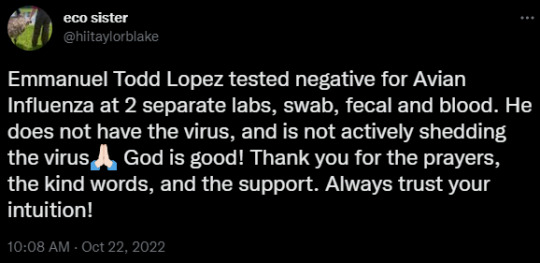
HPAI symptoms in birds varies depending on the species and the individual. In chickens, HPAI often presents as respiratory and digestive distress, followed quickly by death. In other poultry species, symptoms may also include the nervous system, causing “tremors, twisted necks, paralyzed wings, laying down and pedaling”. Ratites- referring to the diverse group of keel-less birds that include emus, ostriches, rheas, kiwis, and cassowaries- also tend to develop neurological symptoms. Notably, emus can present with twisted necks (torticollis), ataxia (discoordination), leg and wing paralysis, inability to stand, decreased food and water consumption, purple discoloration or swelling of the legs and head, and lethargy. This corresponds with many of the symptoms Blake has documented in Emmanuel. And it should, considering that Emmanuel did test positive for HPAI.
Test results completed on October 27th, 2022 at the USDA’s National Veterinary Services Laboratories showed that Emmanuel’s serum sample, collected six days after the start of the outbreak, contained antibody levels that were consistent with recent infection.
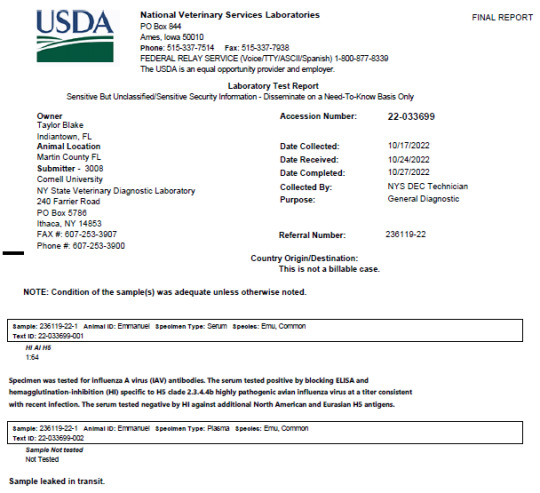
When Blake announced Emmanuel’s stress diagnosis, she was likely relying on information provided by a rapid test, which can provide results within 48 hours. These tests detect viral proteins that indicate active infection and virus shedding. Serology tests, on the other hand, look for the presence of antibodies produced in response to infection, not necessarily active infection. For an indeterminate number of days prior to the sample collection (October 17, 2022) Emmanuel had an active HPAI infection that, rather than stress, likely led to his rapid decline.
Why, then, was Emmanuel not included in the state’s cull on Knuckle Bump Farms? An email between Dr. Michael Short, the FDACS’ Animal Industry Director, and Kassandra Curiel of the FDACS’ Office of the Commissioner, answers this question. Dr. Short states that “USDA guidance is that ratites (emus and ostriches), black swans and exotic pet birds do not have to be euthanized due to lower risk”. Blake echoes this on her Twitter, when she says that “the state only focused on the “super spreaders” which are poultry species and ducks. Ratites aren’t included because they typically aren’t as susceptible.”.
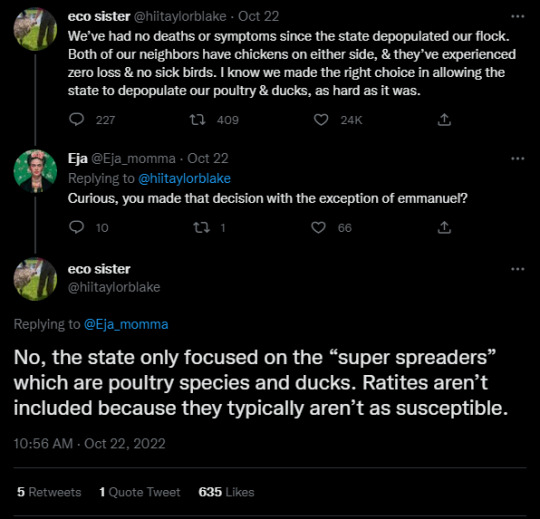
This allowed Knuckle Bump Farms’ four emus (Emily, Eliza, Elliot, and Emmanuel) and three black swans (two unnamed females and Rico), to be exempted from the cull. I cannot find any reference, either in USDA literature or anywhere else, that supports Dr. Short’s statement. In fact, all the literature that I reviewed and all the experts I talked to during my research only confirmed the devastating effects that HPAI can have on both ratites and black swans. This, coupled with the fact that three of Knuckle Bump Farms’ four emus and two of their three black swans died when “the virus hit them extremely hard and very quickly”, calls Dr. Short’s statement into question.
The USDA was also unable to substantiate Dr. Short’s statement. When asked how exemptions to culls were determined they explained that, rather than look at individual species, the USDA classifies HPAI-infected domestic birds as either commercial, backyard poultry, or backyard non-poultry. These definitions ascribe risk of potential HPAI spread by determining the level of contact a poultry premise has with other poultry premises. If a private farm or private household, where the poultry does not have any contact with poultry beyond the property, has an outbreak then they are classified as a non-poultry premises, even if they have chickens, turkeys, or other poultry birds. These non-poultry premises can thus be exempted from culling all their birds by being placed on quarantines by state officials, provided that they adhere to the quarantine and continue to not have contact with any poultry facilities. Knuckle Bump Farms does not sell poultry products; therefore, they were classified as backyard non-poultry and eligible for quarantine. The FDACS seems to have added their own interpretation onto this guidance when they specify ratites, black swans, and exotic pet birds as “lower risk”. I reached out to Dr. Short for comment but received no response.
This isn’t the only time Dr. Short and, by extension, the FDACS demonstrated faulty logic. In that same email between him and Curiel, Dr. Short used this comparison to explain why a citizen’s concern about Emmanuel’s exemption from the cull was unfounded.
“I have heard of only one report of a clinically ill human, over the past 1.5 years of a national response to the current avian flu outbreak. The risk of HPAI to the owner is much less than occurred with household pets that tested positive for SARS-CoV-2 (Covid). I am assuming no one would advocate to euthanize all pets testing positive for Covid (At least I have not heard of anyone asking us to euthanize pets).
The risk of avian influenza is constantly occurring with all the wild birds in South Florida. My understanding (not being a human health expert) is the risk to people, especially children and those immuno-compromised at public or private lakes, ponds and waterways from the AI being shed by water fowl is much greater than the sick emu at knuckle bump farm.”
Dr. Ben Golas, a VMD and postdoc with the USGS who is currently working on avian influenza research, weighed in. “It’s a bit like comparing apples and oranges to talk about risk of transmission of COVID vs. HPAI. With COVID, our primary concern is human-to-human contact. [. . .] With HPAI, farm animals are euthanized not only because the disease spreads within the farm flock like wildfire, but also to prevent spreading infection locally to other farms, because HPAI virus can be stable in the environment.”
The CDC agrees. “There is no evidence that animals play a significant role in spreading SARS-CoV-2, the virus that causes COVID-19, to people. […] It’s important to remember that people are much more likely to get COVID-19 from other people than from animals. There is no need to euthanize or otherwise harm animals infected with SARS-CoV-2.” When it comes to HPAI, however, they emphasize that human-to-human spread is rare and often limited to only a few individuals. Bird-to-human transmission is the primary method of human infection, with each new infection increasing the risk that a new, more virulent strain will emerge. This, along with the potential for massive bird-to-bird outbreaks that could devastate both wildlife and industry, is why complete depopulation (euthanasia) is standard for HPAI and not COVID-19.
The FDACS seems to be operating on contradicting and unsubstantiated information when it comes to managing HPAI outbreaks. Unsurprisingly, the employees seem equally conflicted in their internal emails regarding Knuckle Bump Farms. One Florida USDA representative noted, while forwarding a citizen concern about Blake’s lack of PPE, that “her face is real close to a bird that has HPAI”. Another USDA employee responded “actually, in one of the pictures she appears to be kissing it on the head.”. Dr. Kendra Stauffer of the USDA wrote, “. . . part of the allowing the pet bird to live was that there were rules the owner was to follow from DOH, which clearly she is not”.
Other employees, however, were eager to show their support. Commissioner Nikki Fried of the FDACS posted a photo of her, Blake, and Haggerty, and later posted a photo of herself drinking Knuckle Bump Farms’ branded beer while wearing an Emmanuel t-shirt.
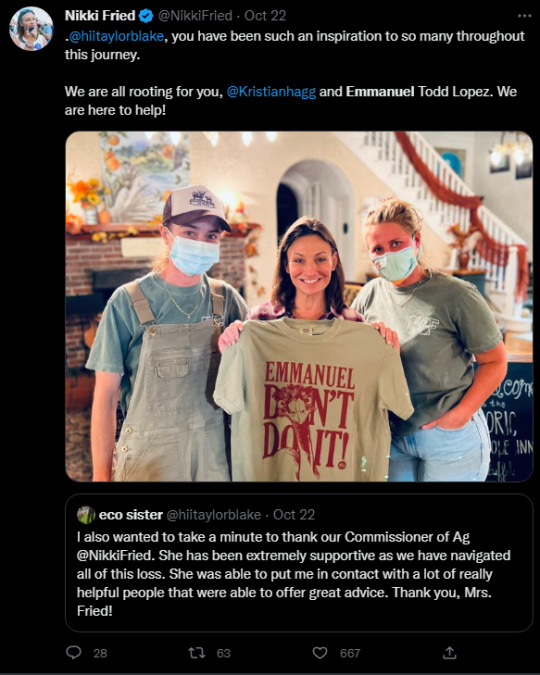
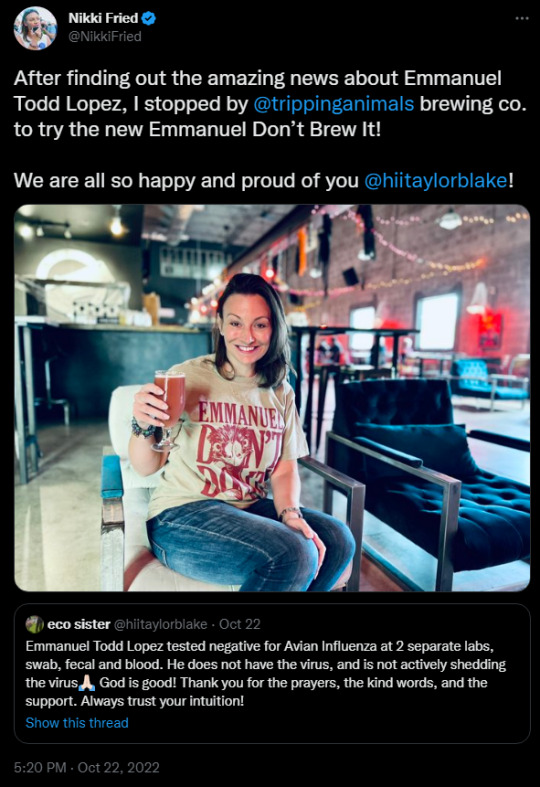
Fried’s support generated a lot of concern, particularly amongst local farmers. One Florida emu farmer stated, “my disappointment and concern is 100% with the actions of Nikki Fried as Agricultural Commissioner to allow some birds to be exempt from depopulation, including emus, for no quantifiable reason. Emus are susceptible to HPAI. Emus in other states have contracted HPAI in this current outbreak and they either died on their own or were put down. Research shows they are susceptible to HPAI, and can spread it to other birds and humans. The decision by Fried and FDACS makes no sense and it sets a dangerous precedent.”
Considering that Blake has over 847.4K followers on Twitter, 938K on Instagram, and 2.4 million on TikTok, the precedent the FDACS and USDA have set here is, indeed, dangerous. Many of Blake’s followers learned about avian influenza for the first time through her documentation of Emmanuel’s illness and the state’s response to the outbreak. “I watch for Emmanuel updates every day! This has also been a great lesson for many people in farming education.”, one follower said. Another echoed this sentiment, saying “Thank you for taking the time to let us know what’s going on, and answering questions. You truly are an educator”.
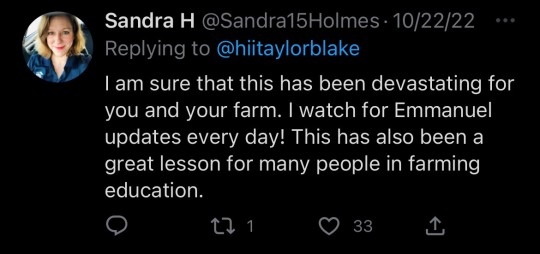

Herein lies the problem. Knuckle Bump Farms is a small, backyard operation. Through social media, however, they reach millions. This specific outbreak of HPAI and its subsequent (mis-)management by the FDACS and USDA has now set the standard for many, rather than the exception. Blake’s public failure to comply with PPE recommendations, the lack of transparency regarding Emmanuel’s true diagnosis, a similar lack of transparency within the FDACS and USDA regarding this outbreak, exemptions to cull protocols made with seemingly no supporting data, and a publicly-elected official openly (and financially) supporting Blake through this process, all pose a serious threat to public confidence in HPAI management and future public health. The concerns of farmers, virologists, public health workers and organizations, wildlife rehabilitators, and animal sanctuaries have been ignored, particularly when they asked whether Emmanuel’s fame and the risk of public backlash led to the FDACS’ decision to leave him and several other symptomatic birds alive. It seems, through this research, that there is more support for this theory than the narrative we’ve been provided until now. It is my hope that, with the publishing of this information, the very real concerns raised by people directly effected by HPAI will be given the weight they deserve.
Please take this opportunity to learn about avian influenza from reputable sources:
Protecting Birds from Avian Influenza
Avian influenza and PPE
CDC Avian Influenza
USDA HPAI Response Plan
Florida Avian Influenza Update (Oct 2022)
A huge thank you to the following experts who generously answered my questions: Dr. Ben Golas, Dr. Jim Wellehan, and Dr. Jennifer Riley.
#long post#incredibly important post#if you read anything today please read this#HPAI#bird flu#infectious disease#Emmanuel the emu#tw animal death#tw disease
2K notes
·
View notes